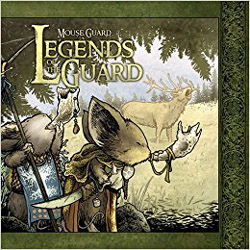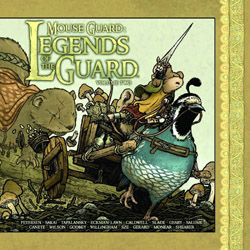Given the popularity and critical acclaim of David Peterson’s Mouse Guard series (as witness our own very positive review of the first book, Mouse Guard: Fall 1152), it was almost inevitable that there would be spin-offs. And indeed, Peterson has brought us one himself, with the aid of a number of collaborators: Mouse Guard: Legends of the Guard.
 Peterson provides continuity for these tales in the form of the June Alley Inn, where June, the proprietress, offers a contest: everyone is to tell a story about the Guard, and the winner of the night’s competition will have his or her tab forgiven; everyone else has to pay up. (There are some hefty tabs running, and June is losing patience.) The Inn provides us a “rogue’s gallery” of the inhabitants of the mouse city of Barkstone, as well as some visitors – the transitions are sometimes as entertaining as the stories themselves.
Peterson provides continuity for these tales in the form of the June Alley Inn, where June, the proprietress, offers a contest: everyone is to tell a story about the Guard, and the winner of the night’s competition will have his or her tab forgiven; everyone else has to pay up. (There are some hefty tabs running, and June is losing patience.) The Inn provides us a “rogue’s gallery” of the inhabitants of the mouse city of Barkstone, as well as some visitors – the transitions are sometimes as entertaining as the stories themselves.
Given the number of stories in these first three volumes — nearly forty — it’s asking for trouble to try to give a blow-by-blow “review” of each one, so I’m going to make some general observations while pointing out highlights and possible flaws.
 Needless to say, at thirteen stories in each volume, the tales are brief, sometimes elliptical to the point of being cryptic: they are sometimes no more than sketches. This is understandable given the probable constraints on submissions, but there are a number of stories that could benefit from more development.
Needless to say, at thirteen stories in each volume, the tales are brief, sometimes elliptical to the point of being cryptic: they are sometimes no more than sketches. This is understandable given the probable constraints on submissions, but there are a number of stories that could benefit from more development.
Several contain no dialogue or narration, only images, and, while I am a great proponent of the images in graphic literature carrying at least a portion of the narrative, given the surround — after all, someone is supposed to be telling these stories – it’s a bit of a head-scratcher.
 It should come as no surprise that there is a wide variation in styles, from Peterson’s own “realistic” renderings through a range from variations on his style all the way to the “cartoony” renderings by Stan Sakai in “Autmun Tale” (Vol. 2), through the somewhat impressionistic images of Ryan Lang’s “The Watcher’s Stone” (Vol. 3) to the wildly abstract drawing by Skottie Young (“The Mouse and the Moon”, Vol. 3). And note that these examples are merely markers, as it were – the artists have filled in the gaps quite completely.
It should come as no surprise that there is a wide variation in styles, from Peterson’s own “realistic” renderings through a range from variations on his style all the way to the “cartoony” renderings by Stan Sakai in “Autmun Tale” (Vol. 2), through the somewhat impressionistic images of Ryan Lang’s “The Watcher’s Stone” (Vol. 3) to the wildly abstract drawing by Skottie Young (“The Mouse and the Moon”, Vol. 3). And note that these examples are merely markers, as it were – the artists have filled in the gaps quite completely.
It should go without saying that, given the number of different artists involved in this project, there is variation in the layouts and, consequently, the narrative flow. Happily, the old standard of Western comics — frame follows frame in an orderly progression across the page — is subject to a lot of variation: the artists have made use of frames of various sizes and orientations to introduce a high degree of visual interest on the page without obscuring the flow of the stories. It’s also worth noting that Peterson has handled the transitions — the scenes in the Inn — so adroitly that, even with the wide variation in style, mood, and content, the overall flow is smooth.
Each volume includes an “Epilogue,” an illustrated gallery of the Inn’s patrons, along with a floor plan, as well as cover galleries of the individual covers from the comic series and biographies of the contributors.
On the whole, if you’re a fan of the original Mouse Guard series, you’ll undoubtedly find the Legends of the Guard rewarding.
(Archaia Entertainment, 2010, 2015, 2016)
